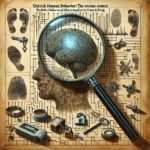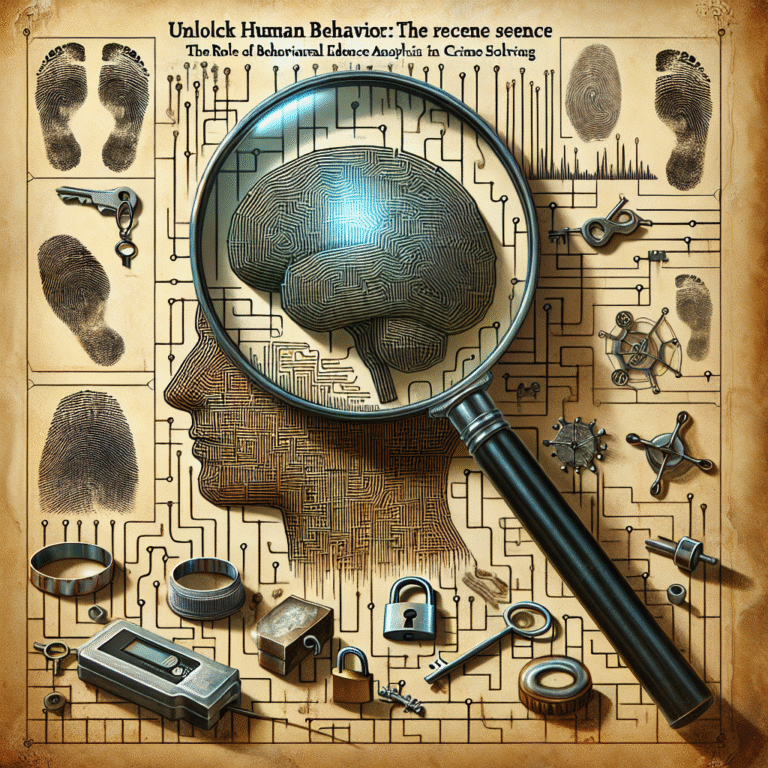
Introduction
Imagine a world where crimes are solved not just through blood, fingerprints, or surveillance footage but by delving into the labyrinth of the human psyche. This is the profound power that behavioral analysis has brought to law enforcement. Unraveling Criminal Minds: The Evolution of Behavioral Analysis in Law Enforcement paints a detailed picture of how understanding behavior can lead to solving complex cases, offering invaluable insights into the art and science of criminal psychology.
As society evolves, so too does crime and the methodology to deal with it. The increasing sophistication of criminal activities calls for advanced approaches. In this article, we will journey through the history, techniques, and case studies that illuminate the pivotal role of behavioral analysis in law enforcement, revealing how it has transformed criminal investigations from mere guesswork to a strategic science.
The Genesis of Behavioral Analysis
Historical Context
Behavioral analysis began to take shape in the late 20th century, amid rising crime rates and the need for more effective policing strategies. Before this era, law enforcement relied heavily on physical evidence. However, it quickly became apparent that understanding the motivations and psychological profiles of criminals could be equally important.
Early Influences
One of the earliest influences on behavioral analysis was the work of psychiatrist Dr. John Money, who advocated for the importance of behavior in understanding criminality. Following Money’s insights, the FBI began to train agents in psychological profiling, leading to the establishment of the Behavioral Science Unit (BSU) in the late 1970s. This move marked a significant turning point in Unraveling Criminal Minds: The Evolution of Behavioral Analysis in Law Enforcement.
The Formation of Criminal Profiling
By the 1980s, criminal profiling began to gain traction. Investigators realized that patterns in criminal behavior could reveal insights into a suspect’s identity, motives, and potential future actions. The FBI’s "Criminal Profile Model," developed by agents like Robert Ressler, utilized this understanding to aid investigations.
Understanding Behavioral Analysis: Key Concepts
Behavioral Typologies
The foundation of behavioral analysis in law enforcement lies in identifying typologies. These typologies can include organized vs. disorganized offenders, based on characteristics such as planning, control, and emotional state during the crime.
Table 1: Organized vs. Disorganized Offenders
| Characteristic | Organized Offender | Disorganized Offender |
|---|---|---|
| Planning | High | Low |
| Control | Maintained | Lacks control |
| Crime Scene | Neat, controlled | Chaotic, disarray |
| Victim Selection | Specific, often known | Random or opportunistic |
| Personality Traits | Calm, confident | Anxious, confused |
The Role of Profiling in Case Resolution
Profiling not only assists in narrowing down suspects but also offers investigative avenues. Analyzing behavioral patterns helps police officers anticipate a suspect’s next move.
Case Studies in Action
The Unabomber Case
One of the most notable applications of behavioral analysis was in the case of Ted Kaczynski, infamously known as the Unabomber. Utilizing profiling techniques, the FBI was able to construct a psychological profile that considered his isolation and education level, guiding the investigation and leading to his eventual capture.
Analysis
The behavioral analysis in the Unabomber case exemplifies how profiling can positively affect investigations. By diving deep into the mind of the criminal, investigators could connect the dots and anticipate his next move, ultimately leading to significant breakthroughs.
The BTK Killer
Dennis Rader, the "BTK Killer," evaded law enforcement for decades. It wasn’t until investigators utilized behavioral analysis that they refined their understanding of his patterns and motivations. This method led to a renewed focus on his profile, resulting in his capture in 2005.
Analysis
The BTK case underscores the importance of continuous behavioral analysis, showcasing how insights into the offender’s life and characteristics can dramatically transform the trajectory of a complex investigation.
The Evolution of Behavioral Analysis Techniques
Modern Approaches
Advancements in technology have transformed methodologies in behavioral analysis. Data analytics, machine learning, and psychological research continue to enhance profiling techniques. Social media and digital footprints are now pivotal tools in understanding criminal behavior.
INTERPOL and Global Collaboration
The rise of global crime has necessitated collaboration between law enforcement agencies worldwide. INTERPOL’s emphasis on sharing behavioral profiles allows for more comprehensive investigations, enhancing the impact of behavioral analysis on international law enforcement.
Chart 1: Global Crime Trends and Behavioral Analysis
| Year | Global Crime Increase (%) | Agencies Utilizing Behavioral Analysis (%) |
|---|---|---|
| 2010 | 3 | 15 |
| 2015 | 5.5 | 30 |
| 2020 | 7 | 50 |
| 2023 | 8.2 | 75 |
Challenges in Behavioral Analysis
Limitations of Profiling
While behavioral analysis has revolutionized law enforcement, it is essential to recognize its limitations. Over-reliance on profiling can lead to wrongful accusations, as seen in certain high-profile cases where misinterpretations caused investigators to focus on the wrong individuals.
Ethical Considerations
Behavioral analysis also raises ethical questions. Profiling can sometimes reinforce societal stereotypes, leading to biased practices. It’s critical for law enforcement to utilize behavioral analysis responsibly, ensuring that justice is not compromised in the process.
The Future of Behavioral Analysis
Increasing Use of Technology
As we move forward, the integration of artificial intelligence and machine learning will likely expand the capabilities of behavioral analysis. Predictive analytics could anticipate criminal activities based on historical data, allowing for proactive law enforcement strategies.
Education and Training for Officers
Investing in education for law enforcement officers on behavioral analysis is essential. Training programs that cover psychological principles and their applications can enhance investigations and reduce the risk of ethical pitfalls.
Conclusion
Unraveling Criminal Minds: The Evolution of Behavioral Analysis in Law Enforcement highlights the transformative journey of criminal investigations. From its historical roots to modern techniques and future prospects, behavioral analysis has become an indispensable tool for law enforcement agencies worldwide. By understanding criminal psychology and embracing technology, law enforcement can effectively combat crime, improving public safety.
Actionable Takeaway
As society evolves, so does the criminal mind. Understanding this evolution is critical for law enforcement. Remaining open to innovative techniques and continuously updating training programs will ensure that future generations of law enforcement officers are equipped to tackle the challenges of modern crime.
FAQs
1. What is behavioral analysis in law enforcement?
Behavioral analysis in law enforcement refers to the psychological profiling of offenders to understand their behavior, motives, and likely next actions.
2. How does behavioral analysis help solve crimes?
It uncovers patterns and indicators that guide investigators toward potential suspects and investigative strategies.
3. Are there any ethical concerns with profiling?
Yes, profiling can sometimes reinforce biases, leading to wrongful accusations or unfair treatment of individuals.
4. What technologies are shaping the future of behavioral analysis?
Advancements in AI, machine learning, and data analytics are significantly enhancing profiling techniques and predictive capabilities.
5. Can behavioral analysis predict future crimes?
While it can inform strategies and anticipate potential criminal behavior based on patterns, it is not foolproof and should be used alongside traditional investigative methods.
In conclusion, recognizing the critical significance of behavioral analysis in law enforcement is not just about understanding criminal minds but also about embracing the evolution of justice itself. The journey is ongoing, but with each advancement, the potential for a safer society becomes increasingly attainable.















